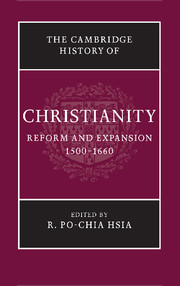Book contents
- Frontmatter
- Part I Luther and the Holy Roman Empire
- Part II The Second Reformation
- Part III Catholic Renewal
- Part IV Resolving Confessional Conflicts
- Part V Religion, Society, and Culture
- Part VI Christianity and Other Faiths
- 26 Christianity and Judaism
- 27 The naturalization of Andean Christianities
- 28 Between Islam and Orthodoxy: Protestants and Catholics in south-eastern Europe
- 29 Christianity shaped by the Chinese
- 30 Reception of Hinduism and Buddhism
- Bibliography
- Index
- References
27 - The naturalization of Andean Christianities
from Part VI - Christianity and Other Faiths
Published online by Cambridge University Press: 28 March 2008
- Frontmatter
- Part I Luther and the Holy Roman Empire
- Part II The Second Reformation
- Part III Catholic Renewal
- Part IV Resolving Confessional Conflicts
- Part V Religion, Society, and Culture
- Part VI Christianity and Other Faiths
- 26 Christianity and Judaism
- 27 The naturalization of Andean Christianities
- 28 Between Islam and Orthodoxy: Protestants and Catholics in south-eastern Europe
- 29 Christianity shaped by the Chinese
- 30 Reception of Hinduism and Buddhism
- Bibliography
- Index
- References
Summary
I enquire in this chapter into what images of Christ, the Virgin and other saints meant to the emergence and ‘fruition’ of local Andean Christianities in the sixteenth and seventeenth centuries.
On one level, saints were the favourite creatures of churchmen and colonial officials and thus might seem to have invited the ‘withering’ and ‘erasure’ of native Andean forms before the force, ‘surveillance and discipline’ of Spanish Christian impositions. They were approved patrons of lay groups and parishbased neighbourhoods, and they immediately authorized not only chapels and churches, but entire towns and cities. There were careful rules for saints’ veneration, systems for how the copies of images and other sacred material would circulate, and regular moments set aside for the promotion and observance of their cults. Official inspectors and representatives set themselves against the saints’ unsupervised proliferation, their untetherings.
And yet, however much saints were meant to play in tune with the universal ambitions of the church and the demands of a colonial system, they joined even more surely to their new people and places. What William A. Christian Jr has found so seminally both in the case of the late medieval and early modern Spanish kingdoms, and in his ethnographic investigations of the same regions, proves as persuasive abroad. Many saints could not keep their distance; they invited social appropriations and personal connections, and they were remembered through increasingly localized stories of apparitions and miracles, and by iconographic syntheses. Saints built particular reputations as the advocates of individuals and special causes. Bits of them, and material associated with their sacred places, could, like memories, be carried away by devotees and activated elsewhere.
- Type
- Chapter
- Information
- The Cambridge History of Christianity , pp. 504 - 535Publisher: Cambridge University PressPrint publication year: 2007
References
- 18
- Cited by

